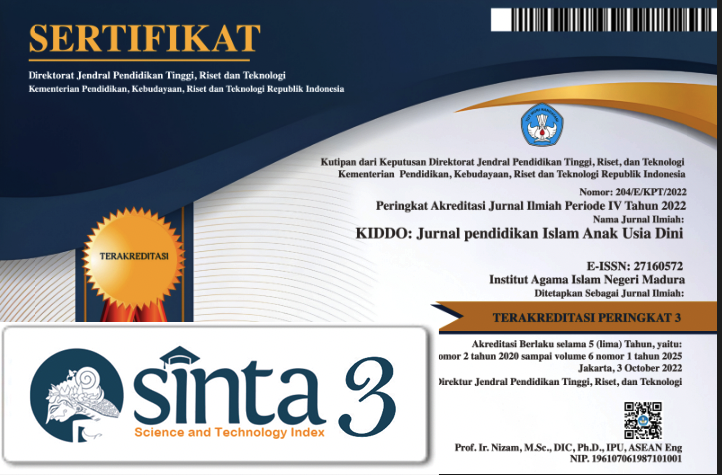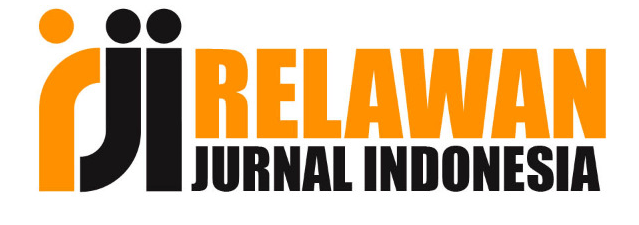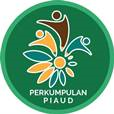CEFR Pada Materi Bahasa Arab: Inovasi Pembelajaran Ramah Anak Pada Sekolah Dasar
 Abstract views: 294
,
Abstract views: 294
,
 PDF downloads: 198
PDF downloads: 198
Abstract
Learning Arabic as a foreign language is best started at an early age, but unfortunately not all schools include Arabic teaching materials in their curriculum. Whereas Arabic is one of the foreign languages whose vocabulary is widely absorbed in Indonesian, it's just that students are not much accustomed to hearing and even using it in conversation, CEFR tries to unravel this as a solution to make learning Arabic fun.The purpose of this study is to test the effectiveness of CEFR as a child-friendly learning innovation in elementary schools. The research method used was mixed method with sequential explanatory type
The result showed that this treatment has effectiveness on students' ability to speak Arabic on al-mihnah material. Through this learning, students not only become brave to express themselves in Arabic but also happier because they learn according to their own abilities and learning styles without having to be forced to memorize at the end of the learning meeting.
Downloads
References
Alfina, A., & Anwar, R. N. (2020). Manajemen Sekolah Ramah Anak Paud Inklusi. AL-TANZIM: Jurnal Manajemen Pendidikan Islam, 4(1), 36–47. https://doi.org/10.33650/al-tanzim.v4i1.975
Aliyya Laubaha, S., Yasin, Z., & Zikran Adam, M. (2022). Problematika Pembelajaran Bahasa Arab Di Madrasah Ibtidaiyah. Assuthur: Jurnal Pendidikan Bahasa Arab, 1(2), 98–108. https://doi.org/10.58194/as.v1i2.475
Barni, M., & Salvati, L. (2017). The Common European Framework of Reference (CEFR). Language Testing and Assessment, 1, 417–426. https://doi.org/10.1007/978-3-319-02261-1_29
Baroroh, R. U., Pohan, N. K., & Hania, I. (2022). Pengembangan Aplikasi Duolingo untuk Meningkatkan Kemahiran Mendengar Siswa Kelas VIII di Ma’had al-Ansor dengan Standar CEFR. Prosiding Inovasi Pembelajaran Bahasa Arab, 67–74.
Çelik, S., Kırkgöz, Y., Irgin, P., Şallı-Çopur, D., Erbay Çetinkaya, Ş., Kurt, M., Makaroğlu, B., Karaca, B., Kavgacı, H., Ozturk, A., & Göktürk-Tüney, N. (2022). Translating the CEFR Companion Volume (2020) into Turkish: The Real Experience Unraveled. Educational Policy Analysis and Strategic Research, 17(4), 274–293. https://doi.org/10.29329/epasr.2022.478.13
Çobanoğlu, F., Ayvaz-Tuncel, Z., & Ordu, A. (2018). Child-friendly schools: An assessment of secondary schools. Universal Journal of Educational Research, 6(3), 466–477. https://doi.org/10.13189/ujer.2018.060313
Diyana, R., Murti, K., & Winarti, E. (2023). PEDADIDAKTIKA: JURNAL ILMIAH PENDIDIKAN GURU SEKOLAH DASAR Desain Pembelajaran Ramah Anak di Sekolah Dasar (Suatu Kajian Teori). All Rights Reserved, 10(3), 506–519. http://ejournal.upi.edu/index.php/pedadidaktika/index
Fahmi, A. (2021). Implementasi Program Sekolah Ramah Anak Dalam Proses Pembelajaran. Jurnal Visionary : Penelitian Dan Pengembangan Dibidang Administrasi Pendidikan, 6(1), 33. https://doi.org/10.33394/vis.v6i1.4086
Hasibuan, A. T., & Rahmawati, R. (2019). Sekolah Ramah Anak Era Revolusi Industri 4.0 Di SD Muhammadiyah Pajangan 2 Berbah Yogyakarta. Al-Bidayah: Jurnal Pendidikan Dasar Islam, 11(01), 49–76. https://doi.org/10.14421/al-bidayah.v11i01.180
Hidayah, N., Mukmin, M., & Eltika, L. (2023). Konsep Aritmetika pada Perubahan Kata Bahasa Arab. Kalamuna: Jurnal Pendidikan Bahasa Arab Dan Kebahasaaraban, 4(2), 153–169. https://doi.org/10.52593/klm.04.2.04
Hidayah, N., Mukmin, M., & Marfuah, S. (2023). The Correlation between Arabic Learning Motivation and Arabic Language Competence of Education Study Program Students in PostCOVID-19 Pandemic. Arabic Education Study Program Universitas Islam Negeri Raden Fatah Palembang, Indonesia 3 Arabic Education Study Program Universitas Tun Hussien Onn, Malaysia, 1(20869282), 3. https://doi.org/10.24042/albayan.v15i2.17453
Hidayah, N., & Muyassaroh, L. (2023). Pembelajaran Bahasa Arab Bagi Non Muslim Berbasis Moderasi Beragama di Sekolah Umum. Jurnal Ilmiah Wahana Pendidikan, 9(3), 103–104. https://doi.org/10.1306/st531003c13
Huttayavilaiphan, R. (2021). “I Apology no no I Mean I Am Sorry … Please Let Me Explain That First”: Enhancing Communicative Language Competence of Thai University Students Through CEFR-Based Online Intercultural Communication. Journal of Education and Learning, 11(1), 87. https://doi.org/10.5539/jel.v11n1p87
Juliar Fahri, A., & Supriadi, R. (2023). Implikasi CEFR Pada Buku Ajar Sahabatku Indonesia Untuk Penutur Bahasa Arab Level 1. Madah: Jurnal Bahasa Dan Sastra, 14(1), 103–111. https://doi.org/10.31503/madah.v14i1.552
Khasanah, R. (2019). Kerangka Pengajaran Bahasa Asing Level A1-A2 dalam Standar CEFR (Studi Pendekatan Filsafat Bahasa). Tesis UIN Sunan Kalijaga, 2018, 32. https://www.academia.edu/download/82217590/JURNAL_KERANGKA_PENGAJARAN_BAHASA_ASING_LEVEL_A1_dikonversi.pdf
Korai, M., & Papadima-Sophocleous, S. (2021). The potential of the CEFR for languages descriptors for mediation in an ESP CALL-based context. Tertiary Education Language Learning: A Collection of Research, 2021, 7–28. https://doi.org/10.14705/rpnet.2021.51.1252
Mukmin, M., Hidayah, N., & Marpuah, S. (2023). Reorientation of The Arabic Language Curriculum for Secondary Education in The Endemic Era Arabiyât. 10(2), 217–229.
Muzammil, A. (2022). Modifikasi Pembelajaran Bahasa Arab sesuai standart International CEFR di Pusat Studi Bahasa Asing Universitas Islam Zainul Hasan. Jurnal Pendidikan Islam: Bahtusna, 4(2), 88–112. file:///C:/Users/62831/Downloads/ahmad-muzammil-pba-1.pdf
Noormaliah, N., & Adrian, Y. (2023). Problematika Guru Dalam Mengajar Bahasa Arab Pada Kelas V SD Islamic Bilingual Science Martapura. Al-Madrasah: Jurnal Pendidikan Madrasah Ibtidaiyah, 7(2), 638. https://doi.org/10.35931/am.v7i2.2045
Nurbaeti, R. U., Zulfikar, Z., & Toharudin, M. (2020). Pembelajaran Ramah Anak Berbasis Pendidikan Karakter Pada Sekolah Inklusi. Jurnal Socius: Journal of Sociology Research and Education, 7(2), 99. https://doi.org/10.24036/scs.v7i2.215
Nurdianto, T., & Ismail, N. A. bin. (2020). Pembelajaran Bahasa Arab Berbasis Common European Framework Of Reference For Language ( CEFR ) Di Indonesia. Al Mahāra: Jurnal Pendidikan Bahasa Arab, 6(1), 13. https://doi.org/10.14421/almahara.2020.061-01
Nurdianto, T., P, N. J., Fatoni, A., & Kalita, S. (2022). CEFR-Based Beginner Arabic Reading And Writing Curriculum Design In Indonesia. Journal of Arabic Learning, 5(3), 718–738.
Read, J. (2019). The influence of the Common European Framework of Reference (CEFR) in the Asia-pacific region. LEARN Journal: Language Education and Acquisition Research Network, 12(1), 12–18.
Riyadi, D. E. (2020). Metode Common European Framework of Reference for Language (CEFR) Dalam Pembelajaran Bahasa Arab. Al-Fakkaar: Jurnal Ilmiah Pendidikan Bahasa Arab, 1(1), 42–59.
Rohman, H., & Rosyadi, F. I. (2021). Pengembangan Bahan Ajar Bahasa Arab Berbasis Common European Framework of Reference ( CEFR ) Untuk Meningkatkan Keterampilan Bahasa Arab Siswa Development of Arabic Teaching Materials Based on the Common European Framework of Reference ( CEFR ) to Improve. Al Mahāra Jurnal Pendidikan Bahasa Arab, 7(2), 1–21.
Royani Meisani, D. (2022). Conditions for teaching English to young learners: Indonesian teachers’ perspectives. English Language Teaching Educational Journal, 5(2), 119–128. https://doi.org/10.12928/eltej.v5i2.4989http://journal2.uad.ac.id/index.php/eltej/index
Salman, S. A., & Septiawati, A. (2023). Suitability of Maharah Kalam Learning Achievement in JSIT Arabic Learning Curriculum With CEFR. Al-Hikmah: Jurnal Agama Dan Ilmu Pengetahuan, 19(2), 231–255. https://doi.org/10.25299/al-hikmah:jaip.2022.vol19(2).9543
Setiadi, S., Kamal, M., Arifah, F., & Ilham, A. (2022). Model Materi Ajar Kitābah Muqayyadah Berbasis CEFR dan Terintegrasi Keterampilan Abad Ke-21. Ta’lim Al-’Arabiyyah: Jurnal Pendidikan Bahasa Arab & Kebahasaaraban, 6(1), 83–94. https://doi.org/10.15575/jpba.v6i1.17347
Sugiyono. (2020). Metode penelitian kuantitatif, kualitatif, dan kombinasi (Mixed Methods) (2nd ed.). Alfabeta.
Syafriansyah, M., & Rosalinda, R. (2023). Desain Bahan Ajar Muhadatsah Bahasa Arab Dalam Perspektif Cefr Di Google Classroom. Jurnal Sains Riset, 13(1), 94–102. https://doi.org/10.47647/jsr.v13i1.904
Toha, H., Ainin, M., & Muassomah. (2023). Implementasi CEFR dalam pembelajaran Bahasa Arab dengan Kitab Arabiyah Baina Yadaik di Pondok Pesantren Manbaus Sholihin Gresik. JALIE: Journal of Applied Linguistics and Islamic Education, 07(01), 133–148.
Ulhaq, N., & Lubis, L. (2023). Penyusunan Materi Ajar dalam Rangka Meningkatkan Keterampilan Berbicara Bahasa Arab pada Siswa. Journal of Education Research, 4(3), 1202–1211. https://doi.org/10.37985/jer.v4i3.361
Wijaya, M., & Hikmah, F. (2023). Problematika Pembelajaran Maharah Qiro’ah Dalam Pembelajaran Bahasa Arab Pada Siswa Madrasah Ibtidaiyah. Jurnal Educatio FKIP UNMA, 9(2), 858–864. https://doi.org/10.31949/educatio.v9i2.4880
Yasin, A., & Tarauni, H. (2023). Pendidikan Bahasa Arab Usia Dini Berbasis CEFR. Jurnal Pendidikan Dan Konseling, 5(2), 1683–1688. http://journal.universitaspahlawan.ac.id/index.php/jpdk/article/view/13156%0Ahttp://journal.universitaspahlawan.ac.id/index.php/jpdk/article/download/13156/10066
Yusoff, Z. S., Gurmani, M. T. A. A., Sanif, S., & Noor, S. N. F. M. (2022). The Effect of Mobile-Assisted CEFR English Vocabulary Profile Word Lists on L2 Students’ Vocabulary Knowledge. Asian Journal of University Education, 18(2), 526–543. https://doi.org/10.24191/ajue.v18i2.18159
Yuyun, Y., Zarkasih, Z., & Sapriati, A. (2022). Implementasi Program Sekolah Ramah Anak di Sekolah Dasar Negeri Kecamatan Marpoyan Damai Kota Pekanbaru. Jurnal Bidang Pendidikan Dasar, 6(1), 10–23. https://doi.org/10.21067/jbpd.v6i1.6122
Zaenuri, M., Kholis, M. N., & Barokah, A. (2020). Analisis Soal TOSA (Test of Standard Arabic) Mengacu Pada CEFR (Common European Framework of Reference For Language). An Nabighoh: Jurnal Pendidikan Dan Pembelajaran Bahasa Arab, 22(02), 169. https://doi.org/10.32332/an-nabighoh.v22i02.2219
Copyright (c) 2024 Nurul Hidayah

This work is licensed under a Creative Commons Attribution 4.0 International License.
-
The journal operates an Open Access policy under a Creative Commons 4.0 International license. The terms of the license are:
Share— copy and redistribute the material in any medium or format
Adapt— remix, transform, and build upon the material for any purpose, even commercially.
1. Authors retain copyright and grant the journal right of first publication with the work simultaneously licensed under a Creative Commons License.that allows others to share the work with an acknowledgement of the work’s authorship and initial publication in this journal
2. Authors are permitted and encouraged to post their work online (e.g., in institutional repositories or on their website) prior to and during the submission process, as it can lead to productive exchanges, as well as earlier and greater citation of published work (See The Effect of Open Access).
Jurnal Kiddo is licensed under a Creative Commons
n Access).














